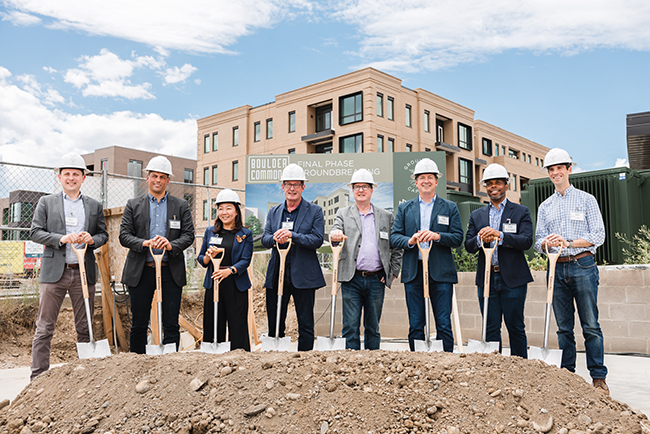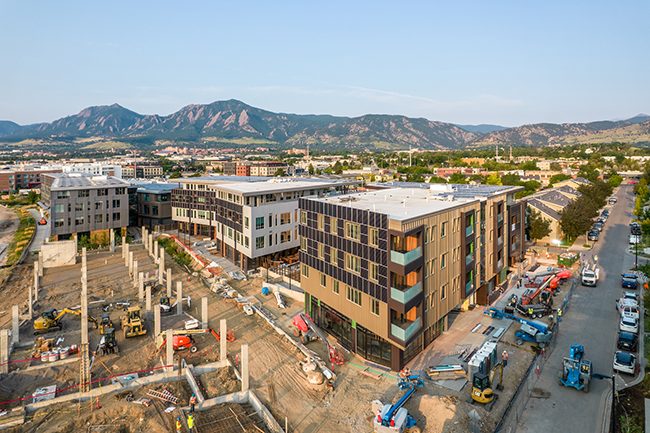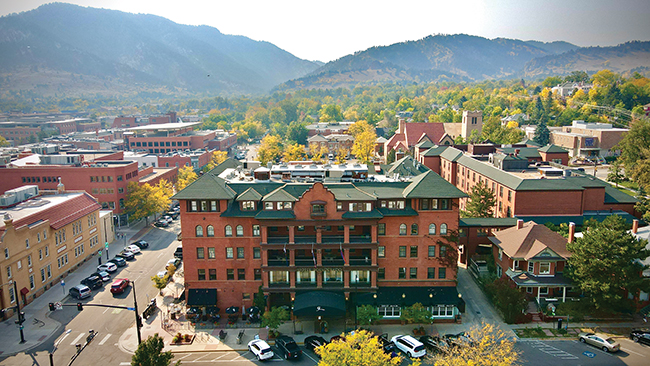Boulder Commons
04 Oct 2023
Building a greener tomorrow, today
By Matt Maenpaa

Solar panels line the roof of the building, some even studding the outer walls like some fantastical imagining of a lunar colony, even as thick-paned windows glare with the sun. This isn’t a scene from a science-fiction film, but instead an architectural concept drawing for a new luxury housing development in Boulder.
Sustainable and eco-friendly developments are becoming more and more commonplace, as some developers attempt to mitigate some of the harms of our changing climate and work to eliminate the use of fossil fuels in new builds. Going beyond just installing solar panels on the roofs of single-family homes, developers like Boulder-based Morgan Creek Ventures are making sustainability and energy-efficiency key focuses on their new luxury apartment buildings.
In July of 2023, Morgan Creek Ventures, in partnership with California-based venture capital firm Grounded Capital, broke ground on the final phase of their Boulder Commons development, which includes luxury apartments, retail space and offices. Located near 30th and Pearl, the luxury building is a part of the city of Boulder’s purpose-built Boulder Junction neighborhood and the ongoing Transit Village Area Plan that the city launched in 2007.
“We’re thrilled to be a part of the vibrant and dynamic Boulder Junction district, where we have incorporated exceptional design into our mixed-used development. With its prime location offering convenient access to bike and nature trails, public transportation and the Google Campus, Boulder Commons embraces the essence of Boulder’s flourishing community, encompassing a multitude of dining, entertainment and future growth opportunities,” said Morgan Creek Ventures principal Andy Bush in a press release.
Earlier buildings in the Boulder Commons project include office and retail space that have been touted as net-zero energy developments, which is to say there are no fossil fuels being used in the buildings and the electricity is provided by the solar panels on the building itself. The residential buildings now under construction won’t be net-zero, according to Parren James, principal at Grounded Capital, but the same design principles have been applied to increase energy efficiency and minimize the carbon footprint.
“There’s not really a compelling reason for anybody to build with fossil fuels or make buildings that use fossil fuels in the future,” James says.
The Boulder Commons project has been designed with consumption in mind, according to James, from the thickness of the walls, roof and windowpanes to air circulation and filtration. Beyond that, the use of energy-efficient lighting and appliances are also taken into consideration during the development and building process.
“We think that creates efficient consumption for the building,” James adds. “That also has a benefit to the tenants, because we’re creating a more comfortable environment for them too.”
Beyond the practical efficiencies, James explains, the intent of the mixed-use development is to create an environment that’s easier for residents to access public transportation, as well as nearby necessities, without having to get in their vehicle. Notably, the developments are all very close to Google’s Boulder Campus, as well as the new RTD hub being built and other offices in the immediate area.
Building with density in mind could be the future, he says, and should help further reduce the environmental impacts moving forward. Providing more opportunities for people to work closer to where they live and play can reduce traffic and car use, furthering the savings and efficiency.
“The tenants benefit from lower [utility] cost and a more comfortable space. Plus, it’s healthier, with a cleaner air quality because we’ve eliminated some of that combustion,” he says. “We’re creating an environment where it’s walkable. You know, maybe you can get a job at one of our office buildings. We’ll get some retail going, you can grab a cup of coffee and enjoy a better quality of life without getting in your car, and I think that’s interesting and exciting.”
The Boulder Commons developments are what James refers to as market-rate and luxury apartments, but the whole area is intended for mixed income buildings as part of the city of Boulder’s plan, he explains.

“Boulder Housing Partners has built affordable and below-market units on two of the quadrants and we’re building market rate units on the other two quadrants,” James says. “So, in effect we’ve supported more affordable housing through the acquisition of the land with Boulder Housing Partners.”
With developments like Boulder Commons modeling the capabilities for environmental consciousness and ecological sustainability in luxury development, James has some hope that the density-focused building and collaboration between private sector investors, developers and policy makers will expand new projects with accessibility in mind in the future. The area now called Boulder Junction has the sort of density that makes it possible, he says.
“That sort of density, we think it creates activation. It creates inclusiveness, the ability to do place-making and create a walkable environment. I know that’s not for everyone,” he says, “but I do think that there could be more of that throughout the country.”
The final stages of Boulder Commons should be completed and available for residence by summer of 2024.












